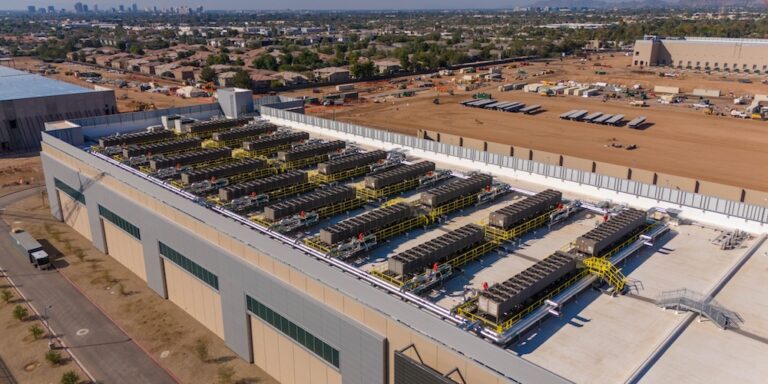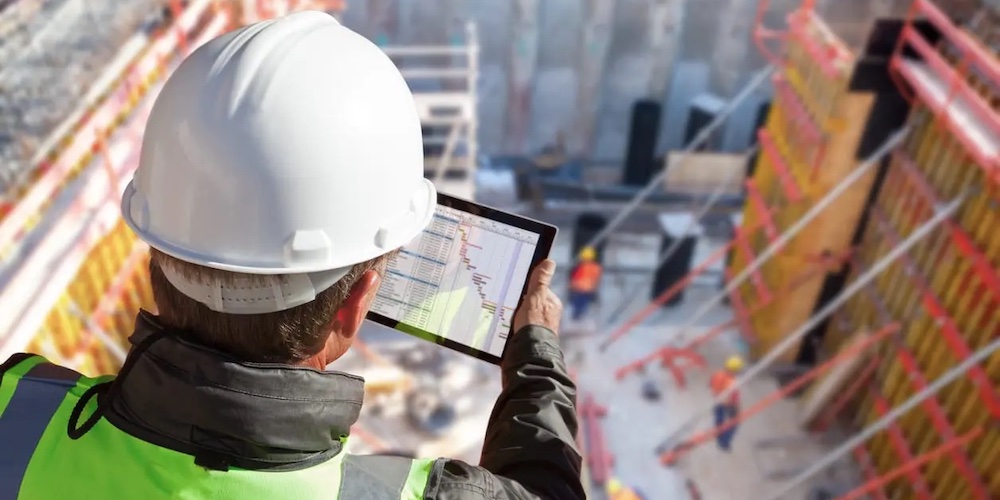— 6 min read
Building for Big Data: An Industry-Wide Challenge to Innovate
Last Updated Apr 28, 2025
Last Updated Apr 28, 2025

The demand for innovative and efficient data centres is skyrocketing. From powering cloud computing and the exponentially growing use of artificial intelligence to supporting the ever-growing internet of things (IoT), data centre facilities continue to be critical infrastructure for a modern, data-centric society.
Construction companies are facing new challenges and opportunities as they adapt to the rapidly evolving landscape of data centre construction. These highly specialised facilities are designed to house sensitive equipment, and they demand advanced tools, cutting-edge solutions and precise execution to meet industry standards.
Table of contents
How the Data Boom is Impacting Construction
The exponential growth of data has significantly influenced the construction industry in recent years. The sheer volume of data generated today demands a new approach to data centre design and construction. These facilities must now accommodate massive amounts of information, requiring innovative solutions that address some key challenges that include:
- Meeting the Demands of Big Data
Building data centres that are capable of handling the ever-increasing volumes of data generated today presents significant challenges for builders. These facilities must be designed with high levels of redundancy, robust cooling systems and efficient power infrastructure to ensure optimal performance and minimise downtime. - Addressing Environmental Concerns
Due to their high energy consumption, data centres can have a significant environmental impact. Construction companies must prioritise sustainability by integrating renewable energy sources, optimising cooling systems and reducing their ecological footprint throughout the building process. - Navigating a Complex Regulatory Landscape
Complying with local and national regulations – including planning permission, environmental regulations and data privacy laws (such as GDPR) – can be complex and time-consuming. - Managing Skilled Labour
Finding and retaining skilled workers with the expertise to design, build and maintain complex data centre infrastructure will continue to be a challenge.
The Evolving Landscape of Data Centre Construction
Many challenges related to data centre construction are interconnected. Issues like energy consumption and efficient cooling are often intertwined. While rural areas may offer ample space for construction, they may also lack readily available power sources, necessitating solutions like on-site power generation.
The rise of AI further complicates the equation.
The increase in AI-driven data generation will require significantly more data centres, and at a much faster pace. While advancements like DeepSeek’s AI model are making data processing more efficient and reducing energy costs, experts warn that these gains could drive even broader AI adoption. This could ultimately sustain or even increase the demand for data centres, rather than reducing it.
Israel Simmons
Civil & Infrastructure Solutions Specialist
Procore Technologies
The ever-increasing demand for data processing power driven by AI necessitates constant innovation in data centre design. However, the rapid pace of innovation in AI hardware can challenge the seamless scalability of data centres. For example, newer chips with higher storage capacity may mean less space is required, but more water for improved cooling could be a trade-off.
Sustainability and diverse national/regional policies around energy consumption, material use and even site selection can also all play a role in design and construction. Khaula says that successful companies are finding their niches in sustainability, innovating in efficient design, construction and MEP (mechanical, electrical, plumbing) practices.
There are companies that are trying to be more efficient and innovative. The companies that are succeeding are the ones making innovation and efficiency a focus.
Israel Simmons
Civil & Infrastructure Solutions Specialist
Procore Technologies
Data centres are increasingly incorporating renewable energy sources like solar and wind. Some companies are even exploring nuclear power, as exemplified by AWS’s 2024 investments in its pursuit of sustainable operations.
Recognising the need for reliable and carbon-free energy sources to support its growing infrastructure, AWS strategically acquired Talen Energy’s data centre campus, located adjacent to the Susquehanna Steam Electric Station in Pennsylvania. AWS has also actively supported the development of Small Modular Reactors (SMRs), a promising advancement in nuclear technology that offers the potential for faster construction and lower costs. These strategic investments and partnerships align with AWS’s stated commitment to achieving net-zero carbon emissions across its operations by 2040.
Cooling Innovation: A Key Factor
One of the biggest challenges in data centre construction is cooling. As data centres continue to grow and manage heavier workloads, conventional air-cooling systems are struggling to keep up. The increasing density of servers produces significant heat, making efficient cooling solutions essential to prevent system failures. Industry experts note that traditional cooling methods are no longer adequate, driving the adoption of more advanced and sustainable technologies.
But there have been some interesting innovations. Microsoft’s Project Natick demonstrated a groundbreaking approach to data centre cooling by submerging a fully functional data centre in the ocean off the coast of Scotland. This solution leveraged the consistent and cool temperatures of the deep sea to naturally cool the servers, eliminating the need for energy-intensive air conditioning systems while prolonging the health and life of the servers.
By utilising the natural environment for cooling, Project Natick significantly reduced energy consumption and demonstrated the potential for sustainable and environmentally friendly data centre operations. While Project Natick was a groundbreaking experiment in data centre cooling, it’s just one of many innovative approaches emerging as companies strive to address one of the most pressing challenges in data centre design and construction.
Innovative cooling technologies, such as liquid cooling and immersion cooling, are gaining traction because they offer significant advantages over traditional air cooling by:
- Improving Energy Efficiency
Liquid cooling systems can be more energy efficient than traditional air-cooling systems, reducing the energy consumption of the data centre. - Increasing Cooling Capacity
Liquid cooling can effectively dissipate heat from high-density servers, enabling higher levels of computing power within the same space. - Reducing Noise Pollution
Liquid cooling systems can operate more quietly than traditional air-cooling systems.
The Future of Data Centre Construction: A Three-Pronged Approach
The future of data centre construction will be shaped by emerging technologies, a focus on sustainability and data-driven decision-making.
The next generation of data centres will be shaped by cutting-edge technologies and a commitment to sustainability. Integrating advancements such as AI, robotics and prefabrication will be key to optimising construction processes and boosting efficiency.
As such, prioritising sustainability is paramount. Incorporating renewable energy sources like solar and wind power into data centre designs is important for reducing the environmental impact. Implementing advanced cooling technologies, such as liquid cooling and free-air cooling, is essential for optimising energy consumption. Additionally, conserving water resources is vital. Utilising water-efficient technologies and implementing rainwater harvesting systems can significantly reduce water consumption.
Construction companies will increasingly rely on data analytics to optimise their operations, improve project performance and make more informed decisions throughout the project life cycle. Project management platforms will play a big role in this process by providing real-time data on project progress, identifying potential risks and issues, facilitating communication and collaboration and optimising resource allocation.
With the rising demand for data centres, the industry is at a key moment. Construction companies and owners that adopt integrated, end-to-end technologies (rather than isolated solutions), prioritise sustainability and leverage data-driven insights will not only overcome emerging challenges but also capitalise on opportunities in this growing market. By constructing smarter, greener and more efficient data centres, they can set new industry benchmarks and spearhead innovation in this ever-evolving landscape.
Categories:
Tags:
Written by
Marlissa Collier
Marlissa Collier is a journalist whose work focuses on the intersections of business, technology, policy and culture. Her work has been featured in digital and print formats with publications such as the Dallas Weekly, XO Necole, NBCU Comcast, the Dallas Nomad, CNBC, Word in Black and Dallas Free Press. Marlissa holds an undergraduate degree in Construction Engineering from California State University, Long Beach and an MBA from Southern Methodist University’s Cox School of Business.
View profileReviewed by
Nicholas Dunbar
33 articles
Nick Dunbar oversees the creation and management of UK and Ireland educational content at Procore. Previously, he worked as a sustainability writer at the Building Research Establishment and served as a sustainability consultant within the built environment sector. Nick holds degrees in industrial sustainability and environmental sciences and lives in Camden, London.
View profileExplore more helpful resources

Construction Management Software: Essential Tools for Modern Building Projects
Today’s construction projects face tighter timelines, rising costs, and increasing compliance pressures. Teams must juggle numerous variables while communicating across multiple job sites, making traditional tools increasingly inadequate. Fortunately, construction...

Building the Ideal Project Team for Data Centre Construction
The digital age has ushered in an era of unprecedented data consumption, fuelling a seemingly insatiable demand for data centres. These complex facilities are driving a construction boom, placing immense...

Construction Scheduling: An Essential Guide
Every successful construction project begins with a solid plan, and at its core lies an effective construction schedule. From breaking ground to final handover, staying on time and within budget...

Gantt Charts: Visual Roadmaps for Construction Success
In the complex world of construction, even well-planned schedules can quickly slip. From overlapping trades to shifting delivery dates, the best-laid plans often unravel. This is precisely why construction Gantt...